A Wide-Band High-Efficiency Hybrid-Feed Antenna Array for mm-Wave Wireless Systems
Abstract
:1. Introduction
2. The Hybrid-Feed 2 × 2 ME-Dipole Sub-Array
2.1. Configuration
2.2. Operation Mechanism
2.3. Performance and Parametric Analysis
3. Design and Measurement of the 8 × 8-Unit ME-Dipole Antenna Array
3.1. RGWG Feed Network Design and Array Configuration
3.2. Measurement of the 8 × 8-Unit ME-Dipole Antenna Array
4. Analysis and Comparison of the Hybrid-Feed ME-Dipole Antenna Array
5. Conclusions
Author Contributions
Funding
Conflicts of Interest
References
- Hong, W.; Jiang, Z.H.; Yu, C.; Zhou, J.; Chen, P.; Yu, Z.; Zhang, H.; Yang, B.; Pang, X.; Jiang, M.; et al. Multibeam antenna technologies for 5G wireless communications. IEEE Trans. Antennas Propag. 2017, 65, 6231–6249. [Google Scholar] [CrossRef]
- Hasch, J.; Topak, E.; Schnabel, R.; Zwick, T.; Weigel, R.; Waldschmidt, C. Millimeter-Wave Technology for Automotive Radar Sensors in the 77 GHz Frequency Band. IEEE Trans. Microw. Theory Tech. 2012, 60, 845–860. [Google Scholar] [CrossRef]
- Zankl, D.; Schuster, S.; Feger, R.; Stelzer, A.; Scheiblhofer, S.; Schmid, C.M.; Ossberger, G.; Stegfellner, L.; Lengauer, G.; Feilmayr, C.; et al. BLASTDAR—A Large Radar Sensor Array System for Blast Furnace Burden Surface Imaging. IEEE Sens. J. 2015, 15, 5893–5909. [Google Scholar] [CrossRef]
- Sohrabi, F.; Yu, W. Hybrid Analog and Digital Beamforming for mmWave OFDM Large-Scale Antenna Arrays. IEEE J. Sel. Areas Commun. 2017, 35, 1432–1443. [Google Scholar] [CrossRef] [Green Version]
- Wu, Y.W.; Hao, Z.C.; Miao, Z.W. A Planar W-Band Large-Scale High-Gain Substrate-Integrated Waveguide Slot Array. IEEE Trans. Antennas Propag. 2020, 68, 6429–6434. [Google Scholar] [CrossRef]
- Jiang, X.; Jia, F.; Cao, Y.; Huang, P.; Yu, J.; Wang, X.; Shi, Y. Ka-Band 8 × 8 Low-Sidelobe Slot Antenna Array Using a 1-to-64 High-Efficiency Network Designed by New Printed RGW Technology. IEEE Antennas Wirel. Propag. Lett. 2019, 18, 1248–1252. [Google Scholar] [CrossRef]
- Qi, Z.; Li, X.; Xiao, J.; Zhu, H. Low-Cost Empty Substrate Integrated Waveguide Slot Arrays for Millimeter-Wave Applications. IEEE Antennas Wirel. Propag. Lett. 2019, 18, 1021–1025. [Google Scholar] [CrossRef]
- Liu, B.; Zhao, R.; Ma, Y.; Guo, Z.; Wei, X.; Xing, W.; Wang, Y. A 45° Linearly Polarized Slot Array Antenna With Substrate Integrated Coaxial Line Technique. IEEE Antennas Wirel. Propag. Lett. 2018, 17, 339–342. [Google Scholar] [CrossRef]
- Luk, K.M.; Hang, W. A new wideband unidirectional antenna element. Int. J. Microw. Opt. Technol. 2006, 1, 35–44. [Google Scholar]
- Li, Y.; Luk, K.M. A 60-GHz Wideband Circularly Polarized Aperture-Coupled Magneto-Electric Dipole Antenna Array. IEEE Trans. Antennas Propag. 2016, 64, 1325–1333. [Google Scholar] [CrossRef]
- Li, Y.; Wang, C.; Guo, Y.X. A Ka-Band Wideband Dual-Polarized Magnetoelectric Dipole Antenna Array on LTCC. IEEE Trans. Antennas Propag. 2020, 68, 4985–4990. [Google Scholar] [CrossRef]
- Sun, J.; Li, A.; Luk, K.-M. A High-Gain Millimeter-Wave Magnetoelectric Dipole Array with Packaged Microstrip Line Feed Network. IEEE Antennas Wirel. Propag. Lett. 2020, 19, 1669–1673. [Google Scholar] [CrossRef]
- Ng, K.B.; Wong, H.; So, K.K.; Chan, C.H.; Luk, K.M. 60 GHz Plated Through Hole Printed Magneto-Electric Dipole Antenna. IEEE Trans. Antennas Propag. 2012, 60, 3129–3136. [Google Scholar] [CrossRef]
- Kim, D.; Zhang, M.; Hirokawa, J.; Ando, M. Design and Fabrication of a Dual-Polarization Waveguide Slot Array Antenna with High Isolation and High Antenna Efficiency for the 60 GHz Band. IEEE Trans. Antennas Propag. 2014, 62, 3019–3027. [Google Scholar] [CrossRef]
- Tomura, T.; Hirokawa, J.; Hirano, T.; Ando, M. A 45 degrees Linearly Polarized Hollow-Waveguide16 × 16-Slot Array Antenna Covering 71-86 GHz Band. IEEE Trans. Antennas Propag. 2014, 62, 5061–5067. [Google Scholar] [CrossRef]
- Kildal, P.-S.; Alfonso, E.; Valero-Nogueira, A.; Rajo-Iglesias, E. Local Metamaterial-Based Waveguides in Gaps between Parallel Metal Plates. IEEE Antennas Wirel. Propag. Lett. 2008, 8, 84–87. [Google Scholar] [CrossRef]
- Ferrando-Rocher, M.; Herranz-Herruzo, J.I.; Valero-Nogueira, A.; Bernardo-Clemente, B.; Herranz, J.I.; Bernardo, B. Full-Metal K-Ka Dual-Band Shared-Aperture Array Antenna Fed by Combined Ridge-Groove Gap Waveguide. IEEE Antennas Wirel. Propag. Lett. 2019, 18, 1463–1467. [Google Scholar] [CrossRef]
- Ferrando-Rocher, M.; Herranz-Herruzo, J.I.; Valero-Nogueira, A.; Vila-Jimenez, A. Single-Layer Circularly-Polarized Ka-Band Antenna Using Gap Waveguide Technology. IEEE Trans. Antennas Propag. 2018, 66, 3837–3845. [Google Scholar] [CrossRef]
- Sorkherizi, M.S.; Dadgarpour, A.; Kishk, A. Planar High-efficiency Antenna Array Using New Printed Ridge Gap Waveguide Technology. IEEE Trans. Antennas Propag. 2017, 65, 3772–3776. [Google Scholar] [CrossRef]
- Cao, B.; Shi, Y.; Feng, W. W-Band LTCC Circularly Polarized Antenna Array With Mixed U-Type Substrate Integrated Waveguide and Ridge Gap Waveguide Feeding Networks. IEEE Antennas Wirel. Propag. Lett. 2019, 18, 2399–2403. [Google Scholar] [CrossRef]
- Cao, J.; Wang, H.; Mou, S.; Soothar, P.; Zhou, J. An Air Cavity-Fed Circularly Polarized Magneto-Electric Dipole Antenna Array With Gap Waveguide Technology for mm-Wave Applications. IEEE Trans. Antennas Propag. 2019, 67, 6211–6216. [Google Scholar] [CrossRef]
- Li, X.; Xiao, J.; Qi, Z.; Zhu, H. Broadband and High-Gain SIW-Fed Antenna Array for 5G Applications. IEEE Access 2018, 6, 56282–56289. [Google Scholar] [CrossRef]
- Ding, Z.-F.; Xiao, S.; Tang, M.-C.; Liu, C.; Shaoqiu, X. A Compact Highly Efficient Hybrid Antenna Array for W-Band Applications. IEEE Antennas Wirel. Propag. Lett. 2018, 17, 1547–1551. [Google Scholar] [CrossRef]
- Saeidi-Manesh, H.; Zhang, G. High-Isolation, Low Cross-Polarization, Dual-Polarization, Hybrid Feed Microstrip Patch Array Antenna for MPAR Application. IEEE Trans. Antennas Propag. 2018, 66, 2326–2332. [Google Scholar] [CrossRef]
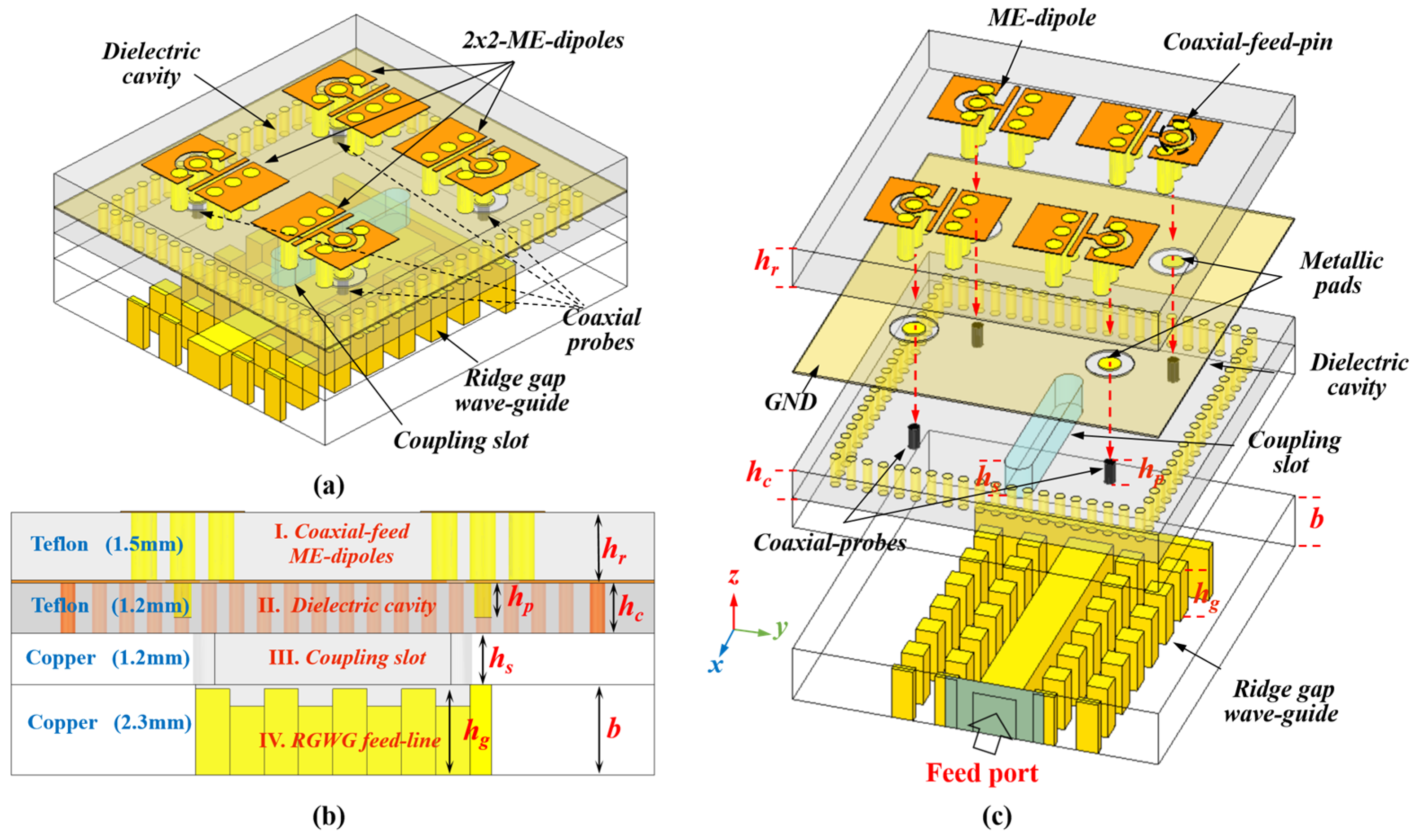

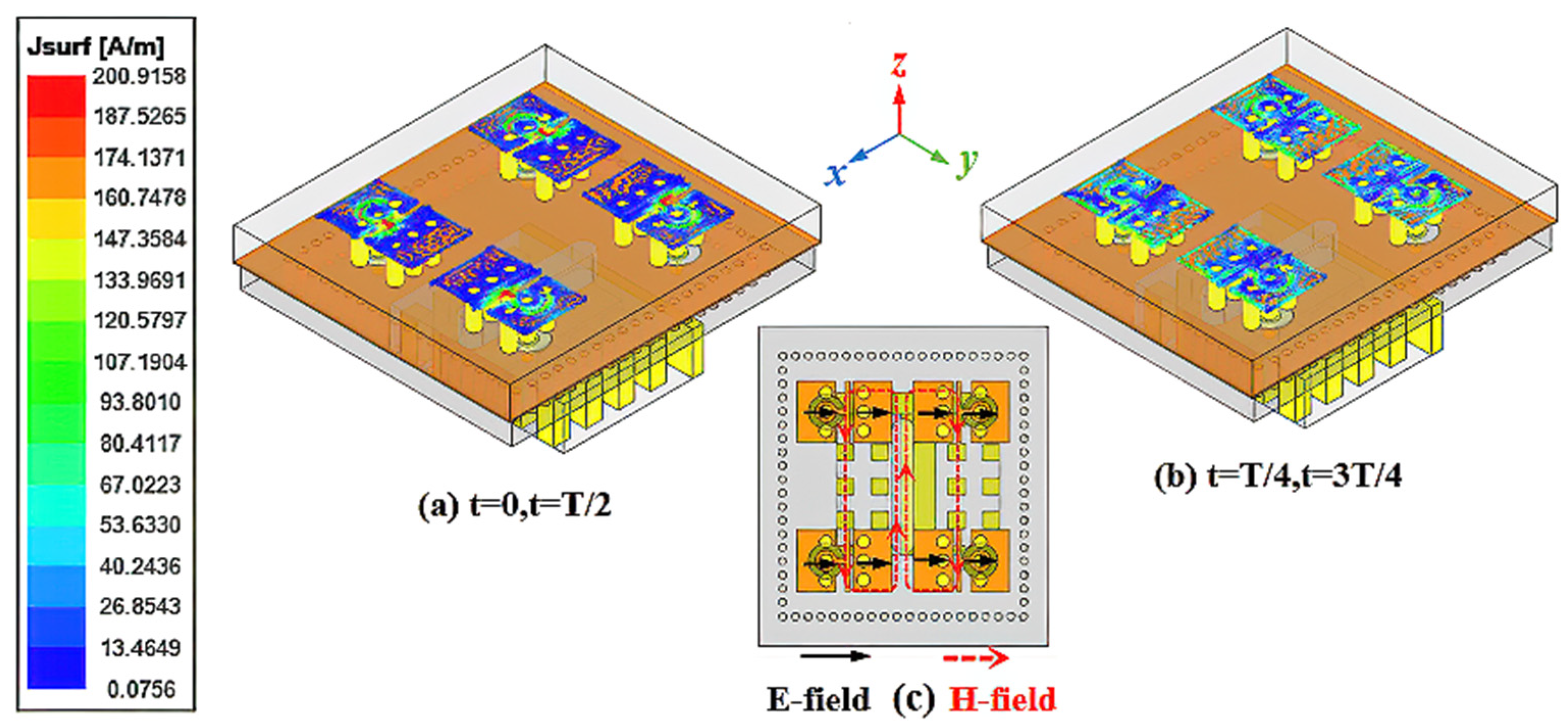
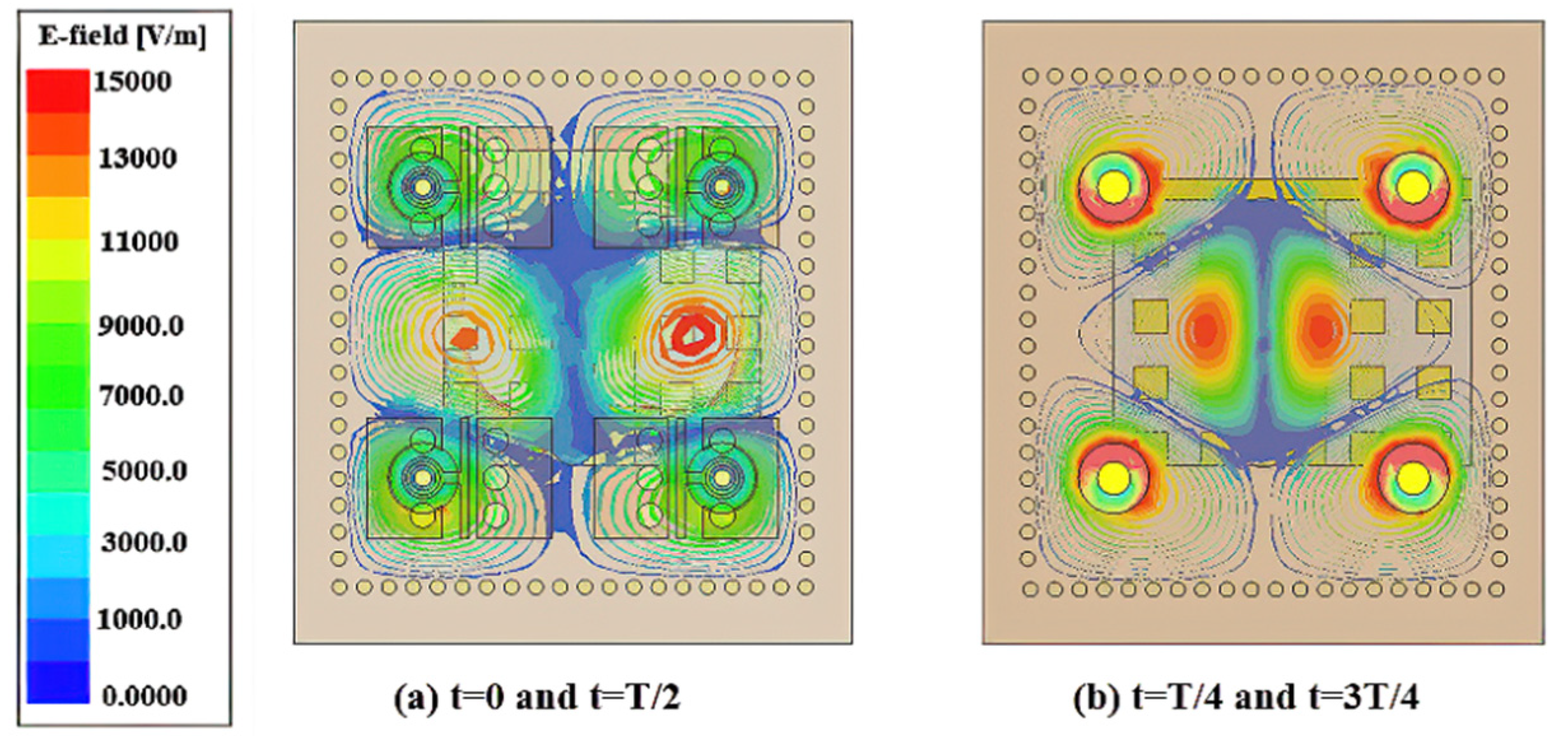


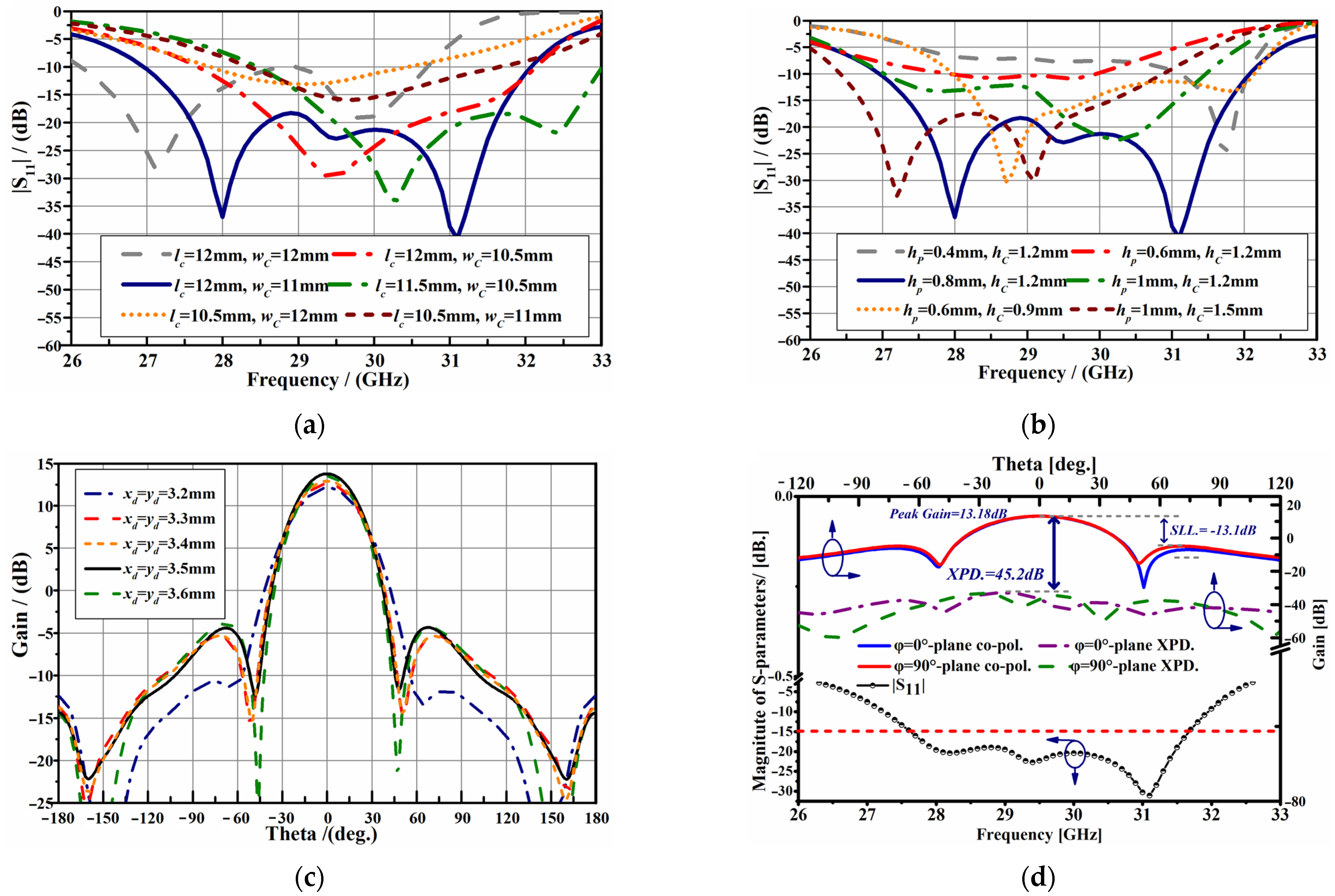


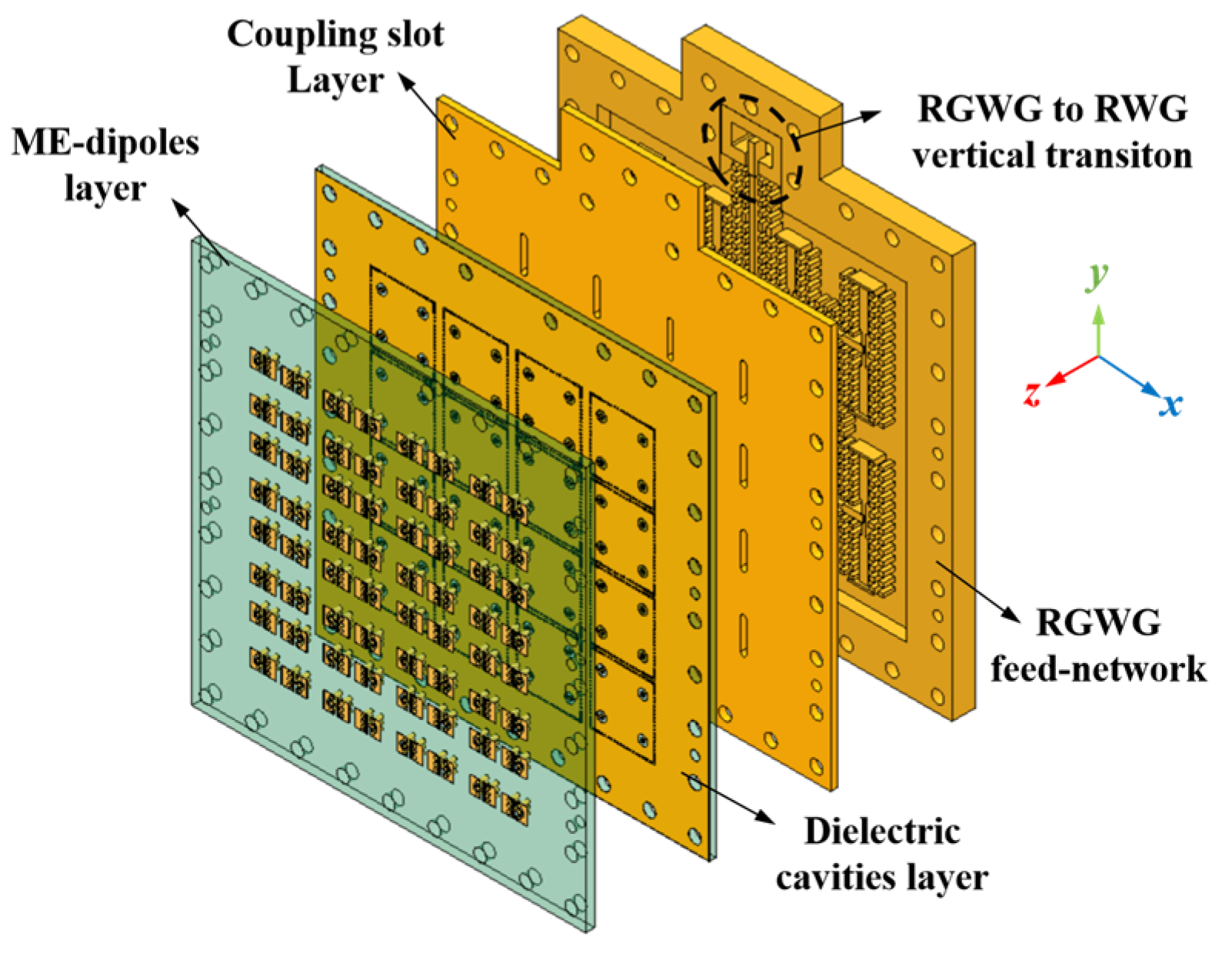
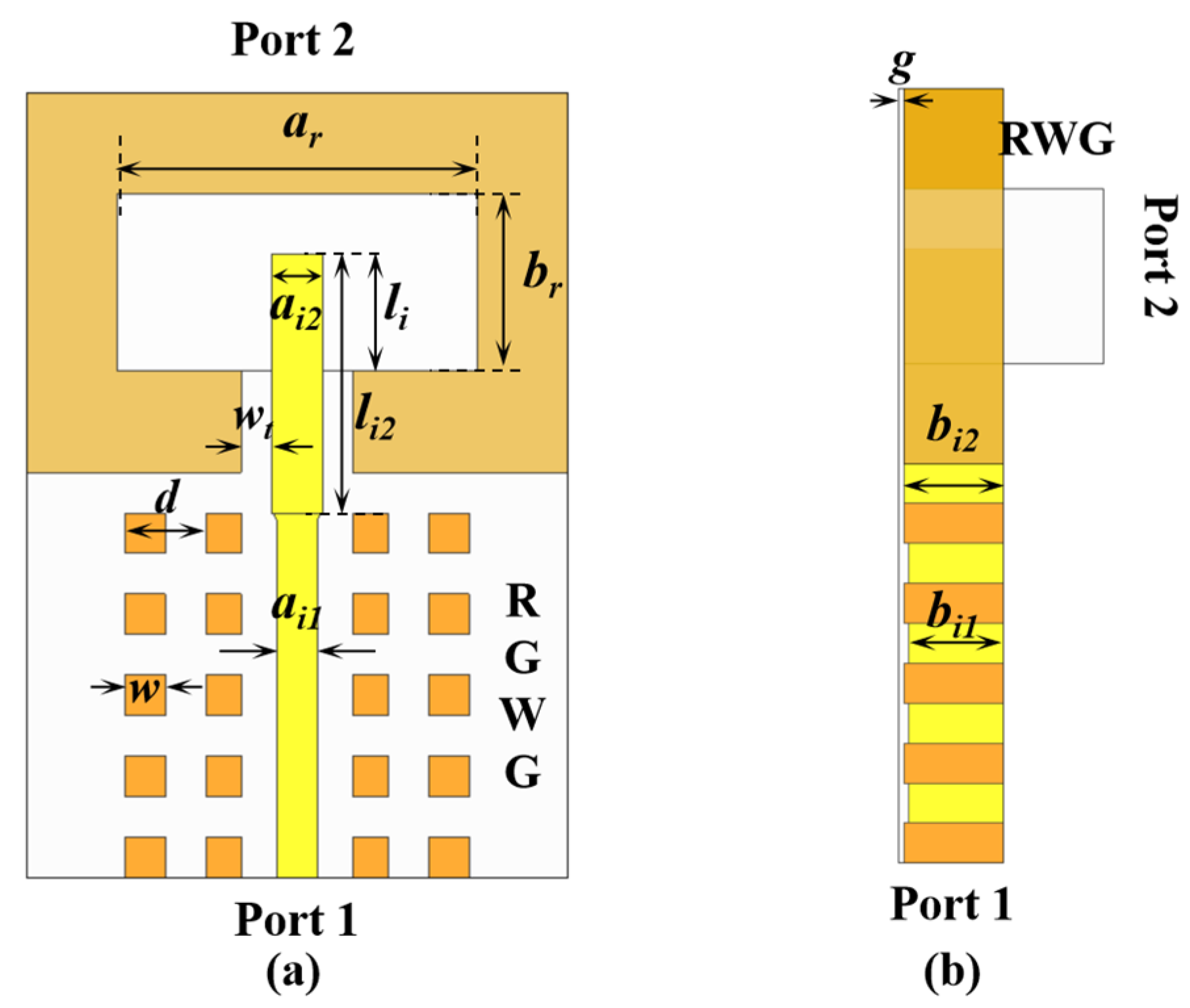
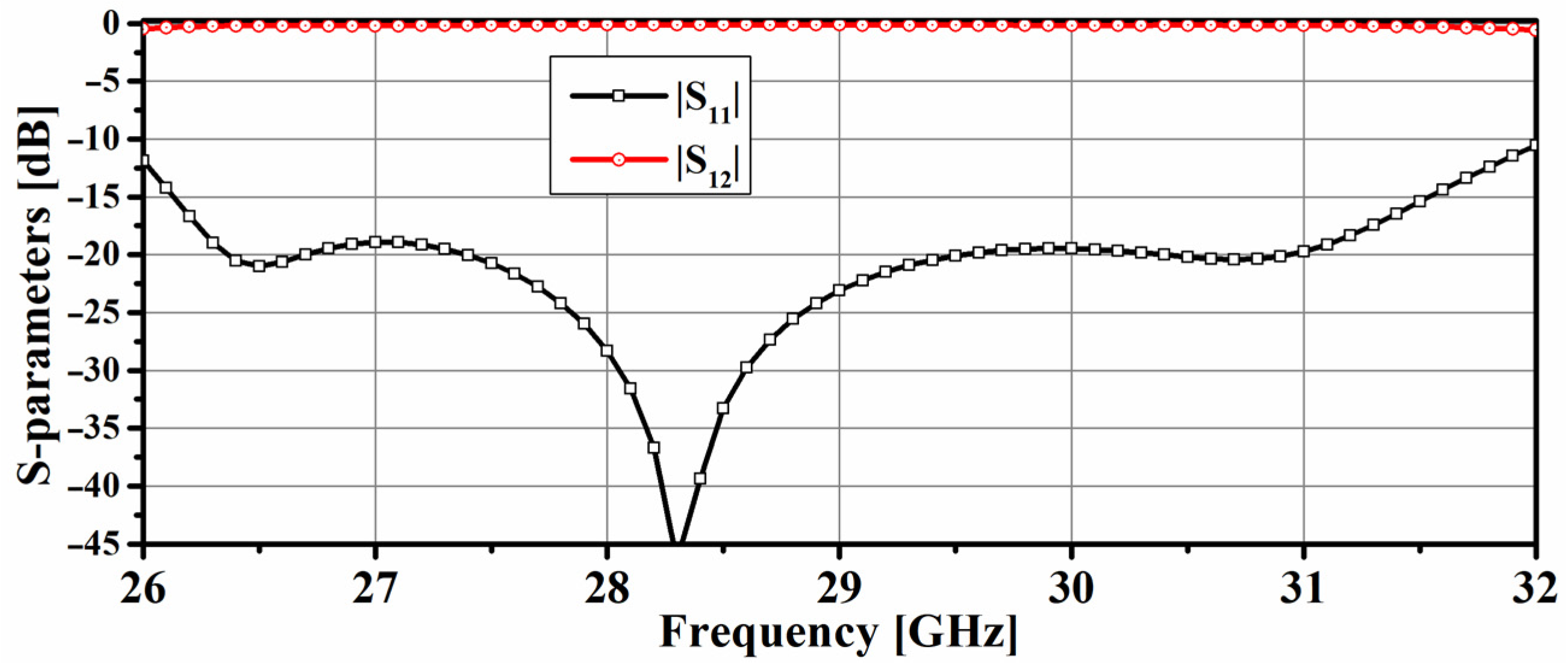
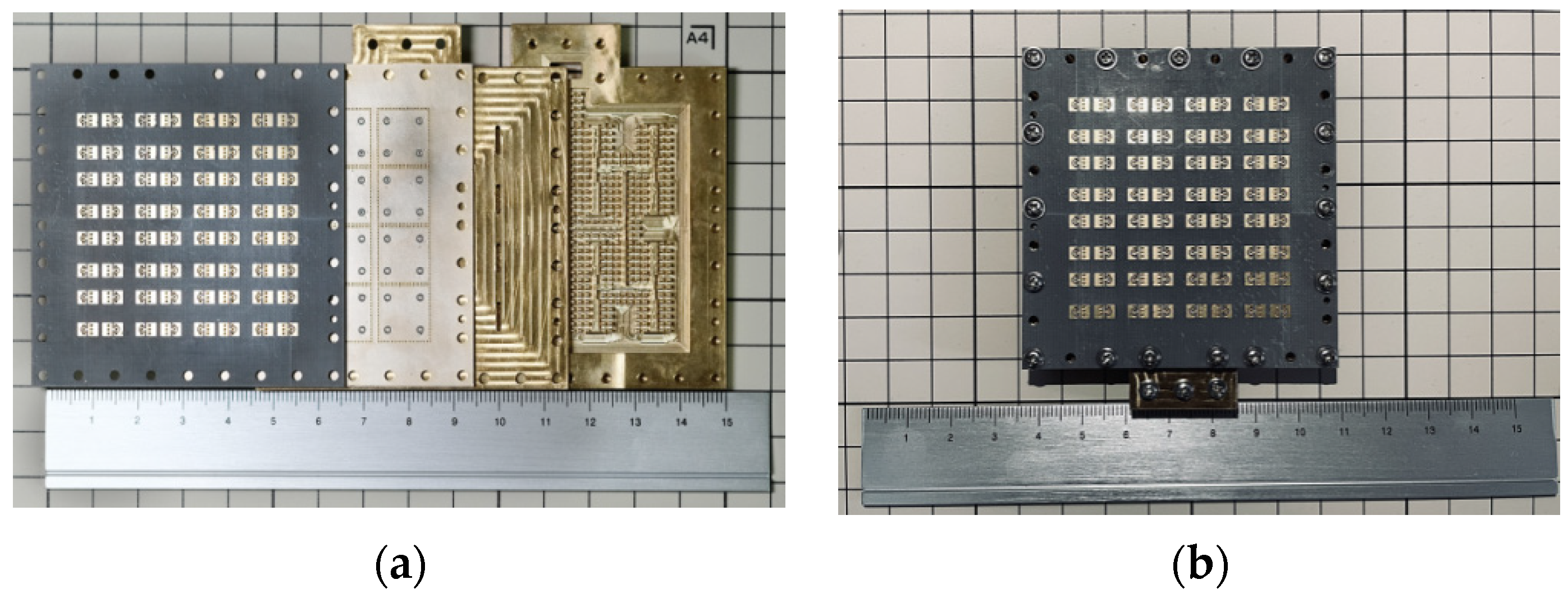

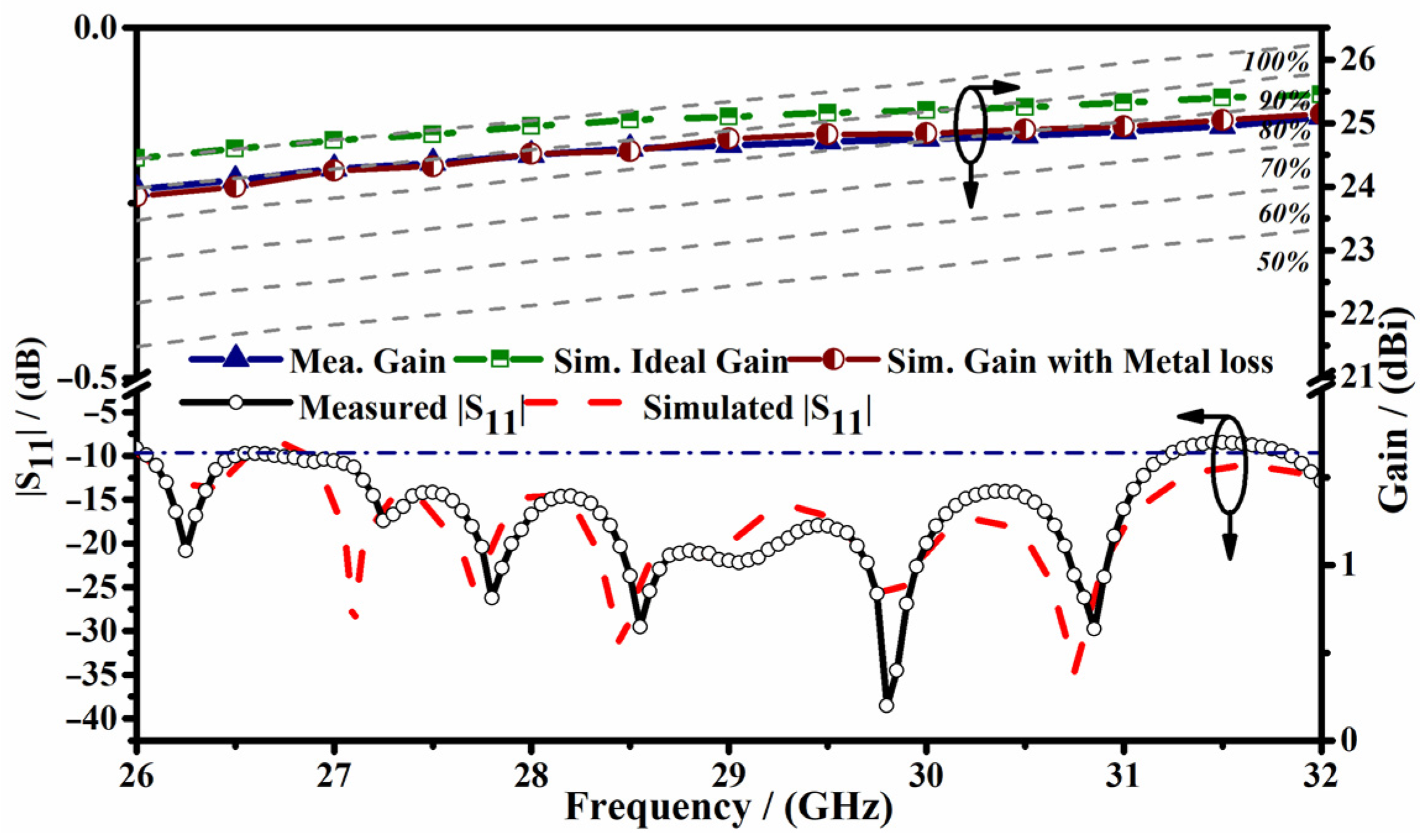
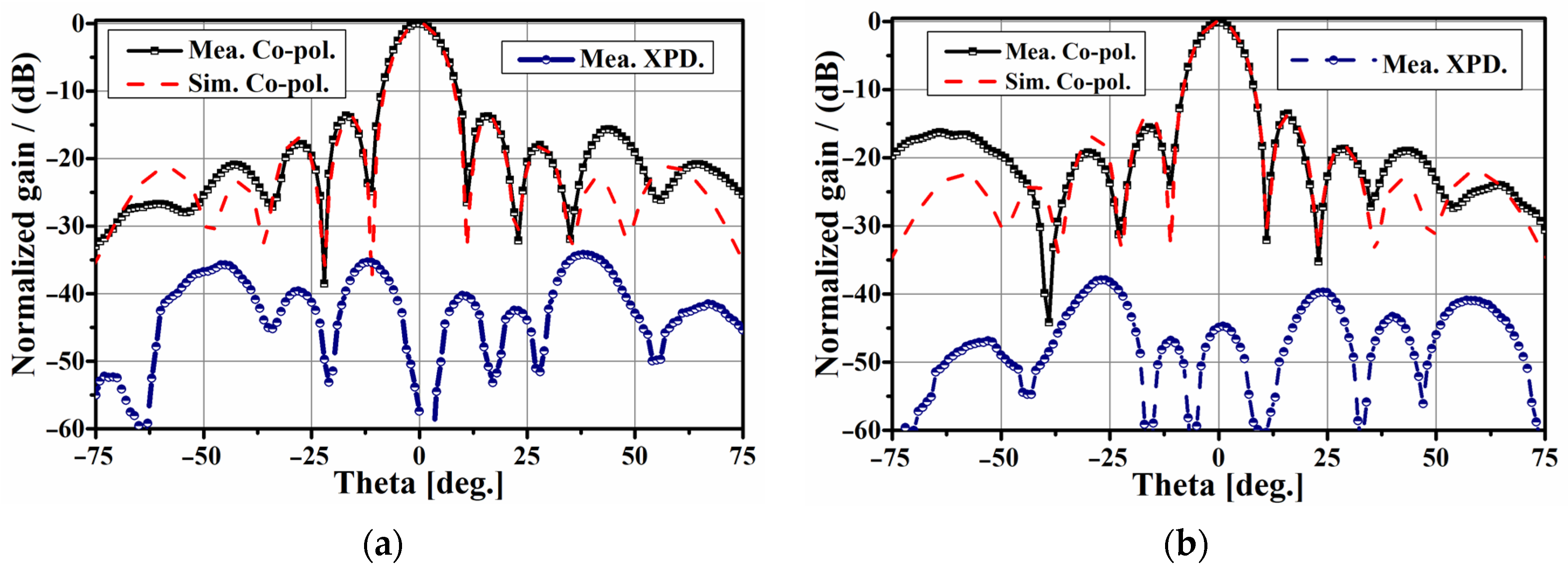
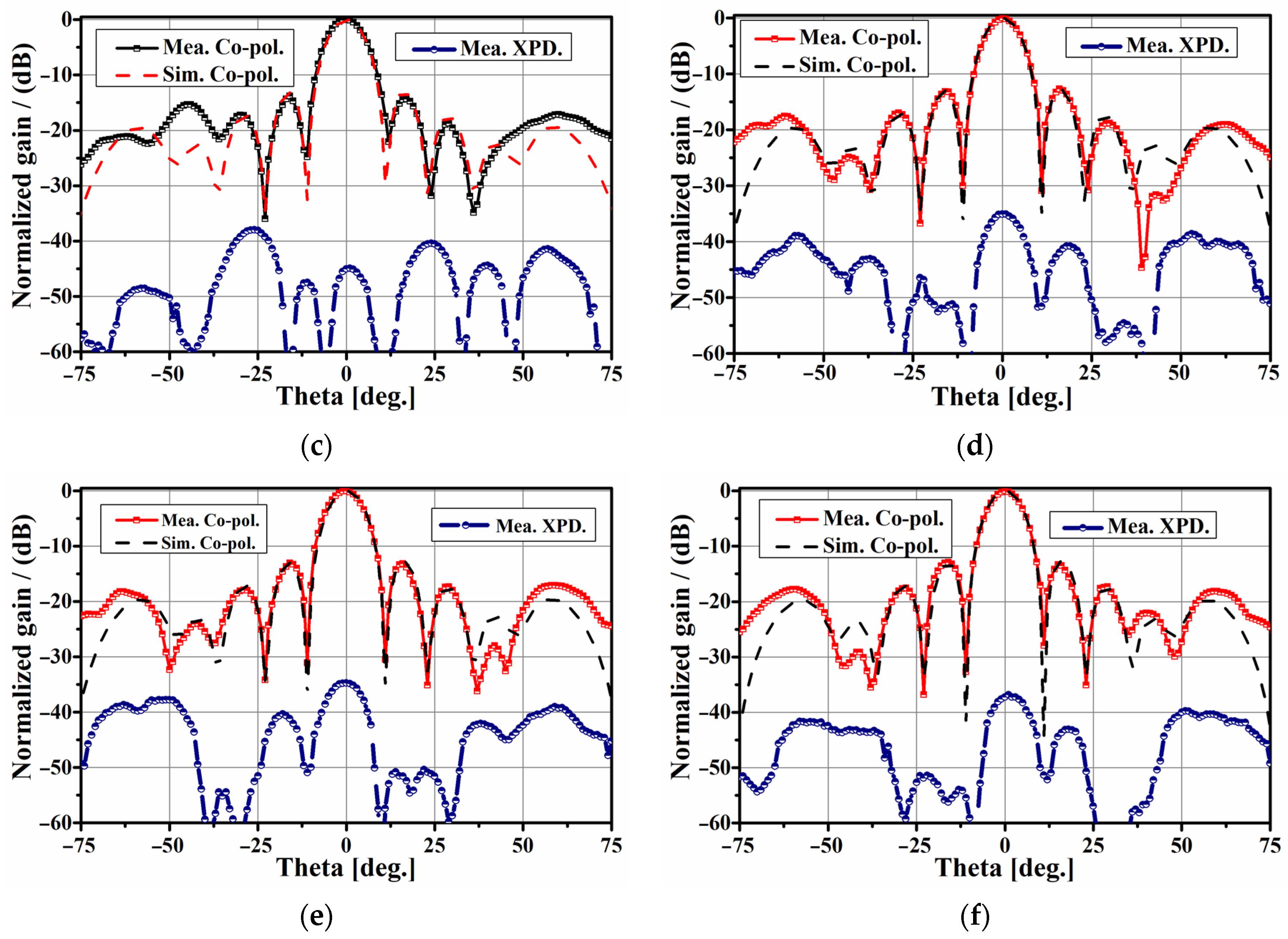

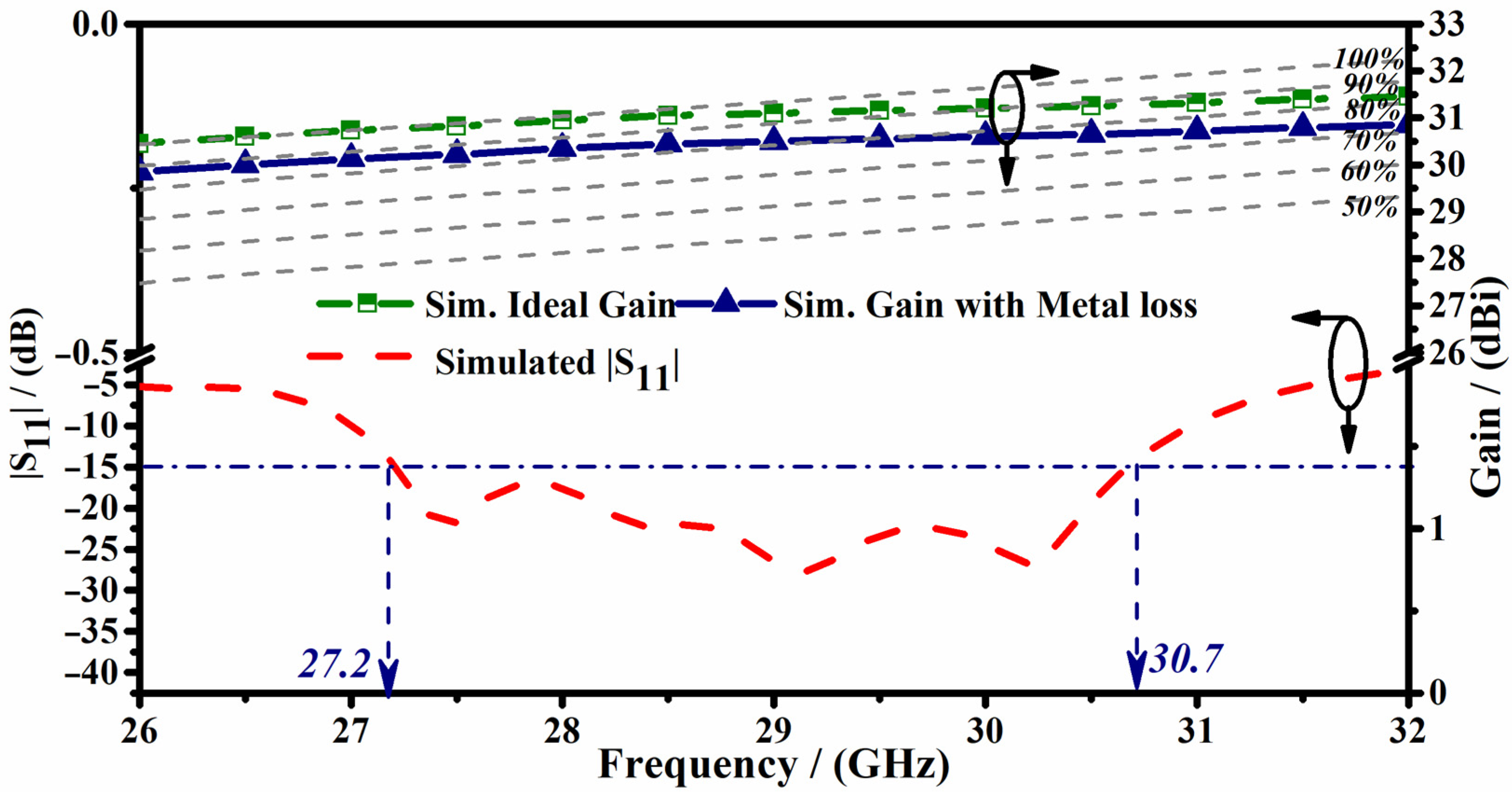

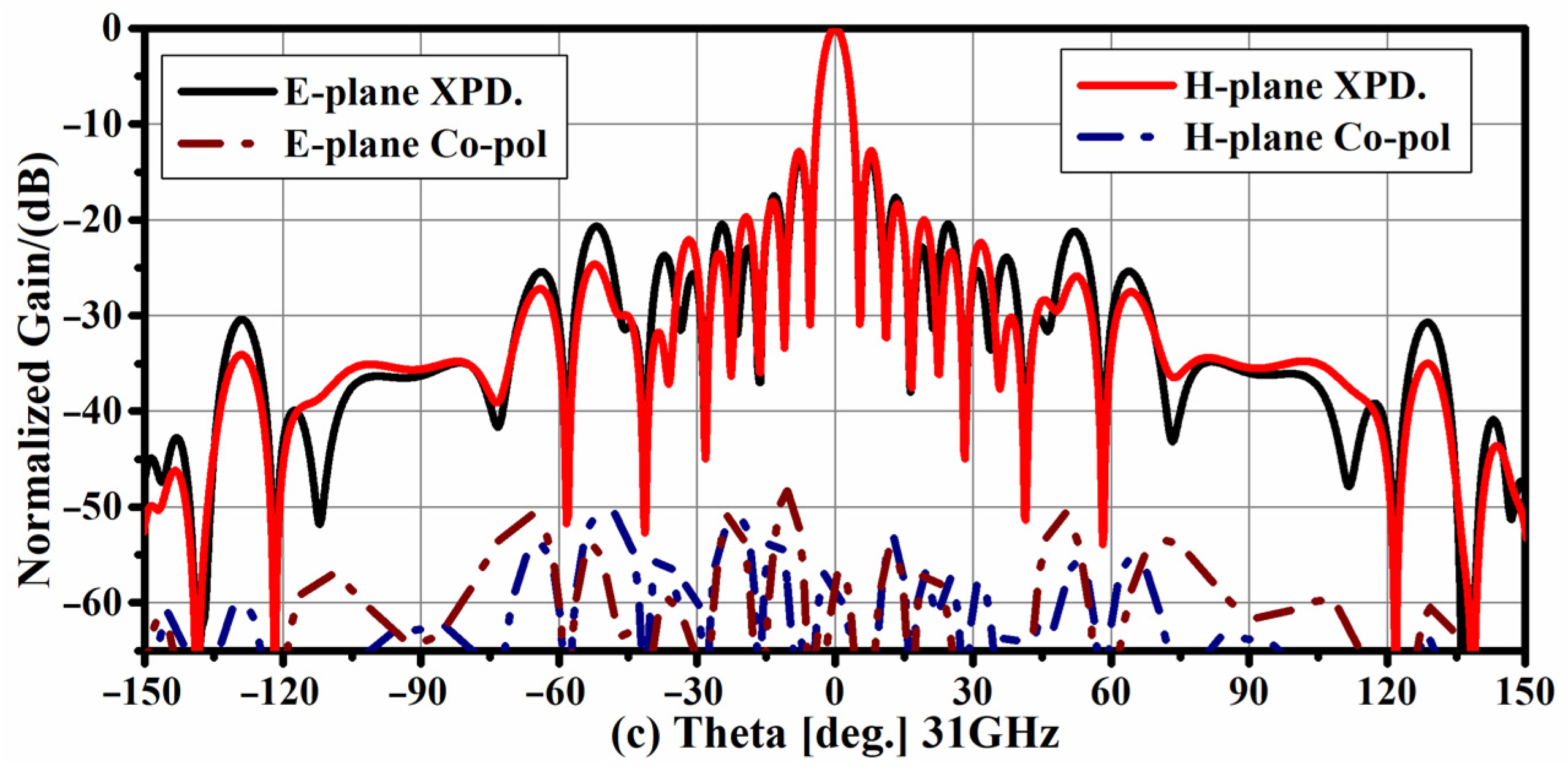
| Parameter | Value | Parameter | Value |
|---|---|---|---|
| wd | 0.85 (0.12 λg) | dc | 0.4 (0.06 λg) |
| hr | 1.6 (0.22 λg) | hc | 1.2 (0.17 λg) |
| din | 0.6 (0.08 λg) | dpat | 1.7 (0.24 λg) |
| dout | 1.6 (0.22 λg) | hp | 0.8 (0.11 λg) |
| wp | 1.8 (0.25 λg) | wl | 0.2 (0.03 λg) |
| lp | 2.9 (0.4 λg) | wf | 0.28 (0.04 λg) |
| ws | 1 | xd | 3.6 (0.5 λg) |
| ls | 6.5 | yd | 3.6 (0.5 λg) |
| wc | 11 (1.54 λg) | a | 3.6 |
| lc | 12 (1.7 λg) | b | 2.1 |
| hs | 1.2 | ain | 1.6 |
| hg | 2 | xm | 0.7 |
| lg | 5 | w | 0.8 |
| d | 1.6 | dr | 1 |
| Parameter | Value | Parameter | Value |
|---|---|---|---|
| ar | 7.112 | br | 3.556 |
| ai2 | 1 | bi2 | 2 |
| ai1 | 0.8 | li2 | 5.1 |
| bi1 | 1.9 | G | 0.1 |
| d | 1.6 | W | 0.8 |
| wt | 0.6 | li | 2.3 |
| Ref. | Bandwidth (|S11| < −10 dB) | Num. of Unit | Array Size (λ0) | Fabrication Process | Max. Gain | Max. Rad. Efficiency | Aperture Efficiency * | XPD. (dB) | Cost |
|---|---|---|---|---|---|---|---|---|---|
| [6] | 16% 34–40.1 GHz | 8 × 8 | 6.4 × 6.4 × 0.17 | PCB | 24 dBi | 41.7% | 48.8% | 30 | Low |
| [8] | 2.6% 33.95–34.86 GHz | 5 × 6 | 5.07 × 3.82 × 0.1 | PCB | 17.09 dBi | 22% | 21.02% | 26.8 | Low |
| [10] | 18% 55.4–66.5 GHz | 8 × 8 | 6.12 × 6.8 × 0.5 | Multi-layer PCB | 26.1 dBi | 70% | 95.8% | 20 | Med. |
| [11] | 45% 25.5–40.2 GHz | 4 × 4 | 2 × 2 × 0.12 | LTCC | 16.1 dBi | 83% | 81% | 15 | High |
| [15] | 20% 71–86 GHz | 16 × 16 | 15.7 × 16 × 0.8 | Diffusion bonding | 32.9 dBi | 86.6% | 61.7% | 30 | High |
| [18] | 3.6% 29.6–30.7 GHz | 4 × 4 | 5.3 × 5.3 × 1.1 | Machining | 22.4 dBi | 99% | 49.2% | 13 | Med. |
| [19] | 16.5% 28.8–34 GHz | 4 × 4 | 3.5 × 3.4 × 0.3 | PCB | 21.2 dBi | 70% | 88% | 35 | Low |
| [21] | 16.4% 86.7–102.2 GHz | 4 × 8 | 11.8 × 11.4 × 2.2 | PCB + machining | 23 dBi | N.A. | 11.8% | 15 | Med. |
| This work | 16.4% 26.05–31.15 GHz | 8 × 8 | 5.4 × 5.4 × 0.6 | PCB + machining | 25 dBi | 85% | 86.2% | 34 | Med. |
| This work | 13.8% ** 27.1–31.1 GHz | 16 × 16 | 10.8 × 10.8 × 0.6 | PCB + machining | 31 dBi ** | 83.2% ** | 85.8% ** | 37 | Med. |
Publisher’s Note: MDPI stays neutral with regard to jurisdictional claims in published maps and institutional affiliations. |
© 2021 by the authors. Licensee MDPI, Basel, Switzerland. This article is an open access article distributed under the terms and conditions of the Creative Commons Attribution (CC BY) license (https://creativecommons.org/licenses/by/4.0/).
Share and Cite
Tan, W.; Xiao, Y.; Li, C.; Zhu, K.; Luo, H.; Sun, H. A Wide-Band High-Efficiency Hybrid-Feed Antenna Array for mm-Wave Wireless Systems. Electronics 2021, 10, 2383. https://doi.org/10.3390/electronics10192383
Tan W, Xiao Y, Li C, Zhu K, Luo H, Sun H. A Wide-Band High-Efficiency Hybrid-Feed Antenna Array for mm-Wave Wireless Systems. Electronics. 2021; 10(19):2383. https://doi.org/10.3390/electronics10192383
Chicago/Turabian StyleTan, Wenhao, Yu Xiao, Cong Li, Kaiqiang Zhu, Hao Luo, and Houjun Sun. 2021. "A Wide-Band High-Efficiency Hybrid-Feed Antenna Array for mm-Wave Wireless Systems" Electronics 10, no. 19: 2383. https://doi.org/10.3390/electronics10192383






